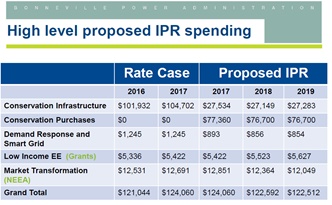The BPA Integrated Program Review (IPR) for 2016 is underway. From BPA’s web site description of the IPR; “The combined Integrated Program Review (IPR) and Capital Investment Review (CIR) process allows interested parties to see all relevant FCRPS expense and capital spending level estimates in the same forum. The IPR/CIR occurs every two years, or just prior to each rate case, and provides participants with an opportunity to review and comment on BPA’s capital and expense program level estimates prior to spending levels being set for inclusion in rate cases. Topics to be covered within the IPR/CIR process include transmission, federal hydro, facilities, information technology, energy efficiency, fish and wildlife and other BPA programs.”
While the IPR is still in process, there are disturbing signs for energy efficiency in the FY2017-2018 period. In essence, BPA is proposing to set EE spending levels in the coming 2 year period at what they describe as “flat” relative to current spending (actually, the table values indicate a small year to year decline).

Even these numbers are placed in context according to BPA. “Customers are seeking changes in BPA’s approach to energy efficiency to address economic, changes in load and market drivers they are experiencing.” And in even more stark terms, relative to the BPA Focus 2028 effort, “[t]his process may change BPA’s EE program and necessitate the need for further conversations regarding proposed spending levels”
Moreover, BPA clearly intends to rely on “momentum savings’ to meet its required obligation to meet the 7th Power Plan conservation targets. NEEC continues to have serious reservations about momentum savings and their status as a measured and verified utility grade resource. While real innovation in approaches to energy efficiency are moving toward meter based savings and away from assumption driven deemed savings values, momentum savings doubles down on calculated savings that have no known connection to a customer meter. When so much energy efficiency opportunity remains in buildings that can be directly observed at a meter and provide the known and quantifiable benefit to consumers and the economy, it seems possible that momentum savings is simply on the wrong side of history.
